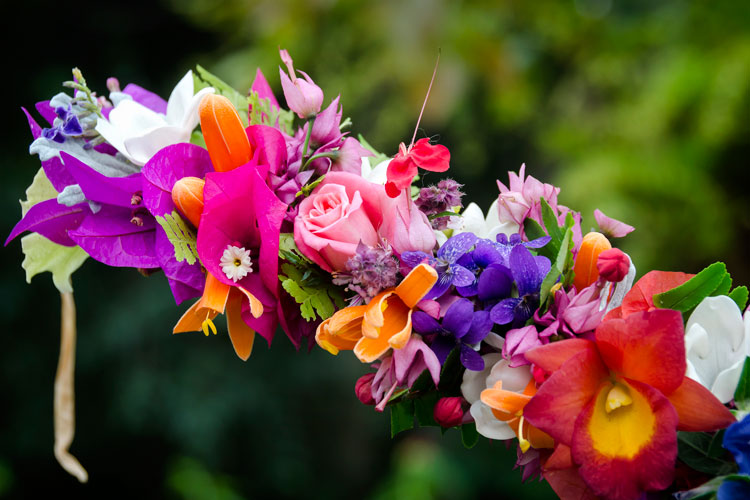Haku Lei, a Hawaiian Crown of Flowers


A handmade haku is a celebration of life. Daniel Lane photo
When I think of aloha, I think of Elvrine Chow, owner of Heavenly Hakus. She glows with joy and her smile is always bright. It must be from working around beautiful flowers. Elvrine spends her days picking flowers in full bloom and weaving them into a haku lei, or head lei, called lei poʻo. People wear them as a crown to celebrate special occasions such as birthdays, anniversaries and promotions. In fact, when we released the first edition of our Kauai restaurant guidebook, Elvrine gifted me a haku for the book signing.

Elvrine spends her days picking flowers in full bloom and weaving them into a haku lei, or head lei, called lei poʻo. Daniel Lane photo
Elvrine is delightful to be around, but when she gets near flowers, bliss radiates from every pore. Several years ago, Dan and I had the opportunity to watch Elvrine make a haku. We were there to video tape Heavenly Hakus for the Kauai Grown program. Her table was piled with baskets full of fresh cut flowers. Every few seconds, her eyes scanned for the perfect color, her hand nimbly grabbed one, and expertly wove it into the haku. In 15 minutes, she was finished!
Elvrine’s favorite way to make a haku is to use the bounty of the season to weave in a variety of colors. Summertime is the best for this as flowers blossom in abundance. People have their own vision as well, so Elvrine custom makes hakus accordingly. She can make them all one color, such as yellow or red, or a rainbow with segments of all red, orange, yellow, green, blue and purple. Male hakus are made masculine by using various shades of green, while white hakus are perfect for weddings.

Elvrine’s favorite way to make a haku is to use the bounty of the season to weave in a variety of colors. Daniel Lane photo
Haku making is a rare art, its craft being lost over generations, so Elvrine decided to write a book to keep the tradition alive. The introduction is a heartfelt mahalo to everyone who has helped her. Inside, residents and visitors model a variety of hakus and Elvrine’s captions describe the celebration and flowers used. In the back there’s a list of some Hawaiian plants as well as instructions for making your own haku, but Elvrine gives workshops if you prefer learning first hand. The book is a lovely tribute to the island of Kauai and honor to Hawaii’s haku custom.

Oahu resident Tara McKellar wears a seasonal haku during one of our Kauai Food Tours. Daniel Lane photo.
You can purchase Elvrine’s book, “Heavenly Hakus Kauai: Hawaiian lei, wili-style, with flower and foliage identification, suggested uses, tips & how-tos” ($20) on Amazon. Or, meet her and get an autographed copy. Watch her make a haku at the Kauai Culinary Market on Wednesdays, the Kauai Community Market on Saturdays and the Kealia Farmers Market every Monday.
“It’s laid back at Kealia, and seems so much like Kauai used to be,” says Elvrine, who will soon offer haku classes by the farm’s waterfall for $50 a person. “Also it’s a poi pick up for many families. Sky Smith splits a weekly bag with her tutu, Jane Gray, director of Kauai Museum (who is pictured in the book).”
Elvrine is at the Kauai Museum once a month on Aloha Fridays. She’ll be there from 10 a.m. to 1 p.m. on Sept. 25, Oct. 9 and Nov.13. The cost is $40 per person with optional lunch for $12.50. Kauai Museum members get a discount.
Elvrine can be reached at 808-634-9999, or heavenlyhakus@aol.com.
